Ford F-Series
| Ford F-Series | |
|---|---|
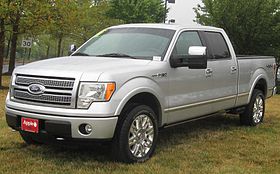 2010 Ford F-150 Platinum | |
| Overview | |
| Manufacturer | Ford |
| Production | 1948–present |
| Body and chassis | |
| Class | Full-size pickup truck |
| Layout | Front engine, rear-wheel drive / four-wheel drive |
| Chronology | |
| Predecessor | Model BB |
| Successor | Ford Super Duty (F-250, F-350, F-450, F-550, F-650, F-750) |
The Ford F-Series is a series of full-size pickup trucks from Ford which has been sold continuously since 1948. The most popular variant of the F-Series is the F-150. It has been the best-selling vehicle in the United States for the past 32 years,[1] and the best-selling pickup for 43 years,[2] and the best selling vehicle in Canada,[3] In the tenth generation of the F-series, the F-250 and F-350 changed body style in 1998 and joined the Super Duty series.
During the post-World War II era, smaller Canadian villages had access to either a Ford dealer or a Lincoln-Mercury-Meteor dealer, but not both; a Mercury-badged version was sold at Lincoln-Mercury-Meteor dealers there from 1946–68. Other than the grilles, trim, and badging, these pickups were identical to their Ford counterparts.
As of 2015, the Ford F-150 is sold in the United States, Canada, Mexico, most Caribbean countries (except Trinidad and Tobago, Saint Kitts and Nevis and Cuba), Suriname, Ecuador, Peru, Chile, the Middle East, Iceland, Nigeria, the Dutch territories of Aruba, Curaçao, Saint Maarten and the British overseas territory of the Cayman Islands whilst the SVT Raptor is sold in the United States, Canada, Mexico, the Middle East, Ecuador, Chile and Peru. Both are available in LHD only. In Mexico, the F-150 is called the Ford Lobo, while the F-150 SVT Raptor is called the Ford Lobo Raptor.
First generation (1948–52)
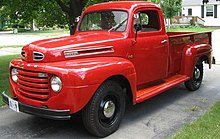
The first-generation F-Series pickup (known as the Ford Bonus-Built) was introduced in 1948 as a replacement for the previous car-based pickup line introduced in 1942. The F-Series was sold in eight different weight ratings, with pickup, panel truck, cab-over engine (COE), conventional truck, and school bus chassis body styles.
Second generation (1953–56)
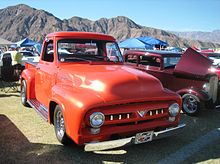
For the 1953 model year, an all-new version of the F-Series made its debut. Increased dimensions, improved engines, and an updated chassis were features of the second generation.
Additionally, a change to the F-Series naming scheme would remain in place to the present day. The half-ton F-1 became the F-100 (partially influenced by the North American F-100 Super Sabre); the F-2 and F-3 were combined into the F-250 while the F-4 became the F-350. Conventional F-Series trucks were F-500 to F-900; COE chassis were C-Series trucks.
Third generation (1957–60)

Introduced in 1957, the third generation F-series was a significant modernisation and redesign. Front fenders became integrated into the body, and the new Styleside bed continued the smooth lines to the rear of the pickup.
The cab-over F-Series was discontinued, having been replaced by the tilt-cab C-Series.
In 1959, Ford began in-house production of four-wheel-drive pickups.
Fourth generation (1961–66)
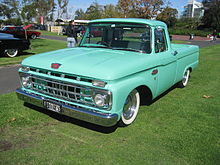
Ford introduced a dramatically new style of pickup in 1961 with the fourth generation F-series. Longer and lower than the previous pickups, these trucks had increased dimensions and new engine and gearbox choices. Additionally, the 1961-1963 models were constructed as a unibody design with the cab and bed integrated. This proved unpopular and the F-series reverted to a traditional separate cab/bed design in 1964.
In 1965, the F-serfies was given a significant mid-cycle redesign. A completely new platform, including the Twin-I-Beam front suspension, was introduced that would be used until 1996 on the F-150 and until 2016 on the F-250/350 4x2. Additionally that year, the Ranger name made its first appearance on a Ford pickup; previously a base model of the Edsel, it was now used to denote a high-level styling package for F-Series pickups.
Fifth generation (1967–72)

Introduced in 1967, the fifth generation F-series pickup was built on the same platform as the 1965 revision of the fourth generation. Dimensions and greenhouse glass were increased, engine options expanded, and plusher trim levels became available during the fifth generation's production run.
Suspension components from all 1969 F-Series models are completely interchangeable.
A variant of the fifth generation F-series was produced until 1992 in Brazil for the South American market.
Sixth generation (1973–79)

The sixth generation F-series was introduced in 1973. This version of the F-series continued to be built on the 1965 fourth generation's revised platform, but with significant modernizations and refinements. Front disc brakes, increased cabin dimensions, gas tank relocated outside the cab and under the bed, significantly improved heating and air conditioning, full double wall bed construction, increased use of galvanized steel, SuperCab was introduced in the sixth generation pickup.
The FE engine series was discontinued in 1976 after a nearly 20-year run, replaced by the more modern 335 series (Modified) and 385 series engines.
In 1975, the F-150 was introduced in between the F-100 and the F-250 in order to avoid certain emission control restrictions. For 1978, square headlights replaced the previous models' round ones on higher trim package models, such as Lariat and Ranger, and in 1979 became standard equipment. Also for 1978, the Ford Bronco was redesigned into a variant of the F-series pickup. 1979 was the last year that the 460 large block engine was available in a half ton truck.
Seventh generation (1980–86)

The 1980 F-Series was redesigned with an all-new chassis and larger body; this was the first ground-up redesign since 1965. The exterior styling of the truck was redone to improve aerodynamics and fuel economy. Medium-duty F-Series (F600-F900) were also redesigned; although they shared the cabin of the smaller pickup trucks, the largest version of F-Series now wore a bonnet with separate front wings (like the L-Series). Medium duty Ford F-Series would carry the 1980-86 interior design until 2000 (though pickups were restyled again in 1987 and 1992), with very subtle changes such as window glass and electronics.
In a move towards fuel efficiency, Ford dropped the M-Series engines (5.8L, 351M and 6.6L, 400 C.I. V8's) in 1981 and added the 4.2L, 255 C.I. and 5.8L, 351 C.I. Windsor V8 engines from the Panther platform. The 255 V8 was simply a 5.0L, 302 V8 with a smaller bore, built specifically for better fuel economy, but was dropped for the 1982 model year due to being underpowered and having limited demand. For 1982 and 1983, the 3.8L, 232 C.I. Essex V6 was the base engine but was quickly dropped for the 1984 model year. In 1983, Ford added diesel power to the F-Series through a partnership with International Harvester (later Navistar). The 6.9L, 420 C.I. IDI V8 produced similar power output as the gasoline 351 Windsor V8, with the fuel economy of the 4.9L, 300 I6. 1985 was the first year of electronic fuel injection on the 5.0L V8, all other engines following suit in 1988. There was a new "high output" version of the 5.8L Windsor beginning in 1984.
A noticeable change was made to the F-Series in 1982 as the Ford "Blue Oval" was added to the center of the grill, also the Ranger and Custom trims were no longer available. The Ranger name had been shifted onto the all-new compact pickup developed as a replacement for the Courier. The new trim levels were a no-badge base model (essentially the new Custom), XL, a very rare XLS, and XLT Lariat.
1983 marked the final year of the F-100, making the F-150 the lightest pickup available on the market. F-100s and F-150s were virtually identical with the exception of smaller brakes and a 5x4.5 bolt pattern on the F-100 axles, as opposed to 5x5.5 on the F-150. F-100s over a certain GVWR and/or without power brakes did use the F-150 axles. Also, the 1980-83 F-100 was never offered with four-wheel-drive.
1986 marked the final year that the F-150 was available with a 3-speed manual gearbox that shifted via a steering column lever (3-on-the-tree). Incidentally, this was the second-last vehicle in the United States that offered this set up. 1986 was also the last year the Explorer package was available.
This is the first generation of trucks to incorporate amenities such as power mirrors, power windows, and power door locks.
Eighth generation (1987–91)

.

Ford's 1987 F-Series carried over the same body style from the 7th generation, yet sported a new rounded front clip that improved aerodynamics, as well as the softening of body lines around the rear of the bed and fender arches around the wheel wells. The interior was also completely redesigned in 1987. The Custom trim made a comeback for the 8th generation. In 1988, the 4.9L I6, 5.8L V8 and 7.5L, 460 C.I. V8 gained electronic fuel injection. International Navistar also increased the displacement of their 6.9L V8 this year, resulting in the new 7.3L, 444 C.I. IDI V8. This was also the first year of a 5-speed manual overdrive transmission, which included the Mazda M5OD in the F-150s and the heavy-duty ZF5 in the F-250s and F-350s. 4-speed manuals were dropped as standard equipment after 1987, but were available as a customer-ordered option until 1989. In 1989, the C6 3-speed automatic was replaced as the base automatic transmission with the E4OD, a 4-speed electronically controlled automatic overdrive unit, though the C6 was still available as an option, mostly in F-250s and F-350s, until 1997. Heavy-Duty models included F-250s and F-350s (along with F-Super Dutys) that were classified as incomplete vehicles that were produced with no bed, but appeared as tow trucks, box trucks (notably U-Haul), flatbed trucks, dump trucks and other models from 1987 to 1997.
Ninth generation (1992–96)

The F-Series underwent another minor cosmetic update for the 1992 model year with an updated front clip focused on increasing its aerodynamics. The update also brought the F-Series in line with the Ranger and Explorer stylistically. The interior was also redesigned at this time. One major interior update included the addition of rear speakers. The XLT Lariat name was shortened to simply XLT in 1992, and Ford's base Custom truck trim became the XL.
SuperCab models of this generation are distinguished by single (instead of twin) side windows for the rear seat. Dormant since 1987, the FlareSide bed also returned for 1992. Instead of the traditional pickup bed seen before, the new FlareSide borrowed much of its rear bodywork from the dual rear-wheel F-350.
Ford offered a 75th anniversary package on its 1992 F-series, consisting of a stripe package, an argent colored step bumper, and special 75th anniversary logos.
In 1995, the medium-duty trucks received their first exterior update since 1980 that integrated the indicators and grille. Also, Ford upgraded the F-Series top trim level with the plusher Eddie Bauer Edition, previously only available on Broncos since 1985. SuperCab models offered new 40/20/40 split bench/bucket seat to replace the previously 50/50 split jump seats.
All 1996 F-150s received mass air flow sensors, replacing the older speed/density set up. 1996 and some late 1995 F-150s also have OBD-II, replacing the old OBD-I system. The F-250HD and F-350, however, would remain unchanged through the 1996 model year.
E4OD transmission changes
The E4OD electronically-controlled transmission with overdrive also underwent several updates during the 1992–1997 model years. For the 1992 year model, the E4OD received four-pinion planet carriers, an updated sun gear, rear case bushings, and a stronger overdrive clutch cylinder snap ring. For the 1994 model year, the transmission received updates to the center support, replacing bushings with ball bearings. A new, stronger four-pinion planet overdrive carrier replaces older three- and four-pinion designs. A revised converter clutch piston was also added in with the 1994 update. 1995 E4OD transmissions received a higher displacement front pump, which helps engage reverse quicker. 1996 was updated to be compatible with OBD2 systems.
Powerstroke diesel
Starting in 1994.5, Ford offered the F-250 and F-350 models not only with gasoline engines, but with new redesigned direct injection turbodiesel engines. The 7.3 liter diesel was manufactured by the International company, also known as Navistar. International upgraded the 7.3 diesel previously used in Ford heavy duty trucks and added a direct-injection fuel system, larger single shot injectors, a turbocharger, and newly designed pushrods. Ford named the new diesel engine the Powerstroke. The Powerstroke brought better performance, power, and towing capacity in Ford trucks. The 7.3 Powerstroke diesel lasted until 2003.5, when it was replaced by the 6.0 Powerstroke. In 1999 an intercooler and new piston rods were included in all Powerstroke diesel engines.
SVT Lightning
The first SVT Lightning truck entered the scene in 1993. It featured a 5.8 L engine with performance GT40 cylinder heads shared with 5.0 Mustang Cobra, cam, pistons, intake shared with the 5.0 H.O. Mustang, headers, dual exhaust, oil cooler and modified engine computer programming. The truck was available with a reprogrammed E4OD automatic transmission with an auxiliary cooler. The rear axle was a limited slip unit with 4.10:1 gearing. Ford added a high-mount third brake light to the rear of 1994 truck cab roofs. More safety-related moves this year included a security package with remote keyless entry and intrusion alarm; also driver airbag was standard on the F-150 for the first time.
Tenth generation (1997–2003)

Introduced in late of 1996, the 1997 F-150 was redesigned from the ground up for the first time since 1980. Rounded styling allowed for improved aerodynamics, a larger interior, and improved fuel economy. Sharing a similar V6 engine with the Taurus/Windstar and a V8 engine with the Crown Victoria and Mustang, late 1997 F-150 received an all-new 5.4L engine. To improve rear-seat access, a third door was added to SuperCab models; in 1998, all SuperCabs became four doors. For 2001, the SuperCrew crew cab was added; it combined the larger seat of a crew cab with a slightly shortened rear cargo bed. The tenth generation F-150 was available in XL, XLT, Lariat, King Ranch, and the special Harley-Davidson edition.
This generation of the F-Series marked the split of the F-150 from heavier-duty pickups. For 1997, all F-150s and lighter-payload F-250s used the new chassis, while heavy-payload F-250s and larger trucks remained on the existing platform. For 1998, only the F-150 and F-250LD were produced. In 1999, the F-250LD was rebadged the F-150 7700, and a new line was introduced, the Ford Super Duty. Super Duty models ranged from the F-250 through the F-750; the F-250 through F-550 (the latter being a chassis-cab model) were Ford manufactured and intended to replace the F-250 through F-Super Duty, while the F-650/F-750 was a joint venture with International, a replacement for the previous medium-duty trucks. In 1999, Ford developed and released the 20-valve Triton V10, 6.8L (415 CID) making 305 horsepower and 425 lb-ft of torque.
For 2002, a variant of the F-150 was sold by Lincoln-Mercury dealers as the Lincoln Blackwood. The first Lincoln pickup, the Blackwood was an F-150 SuperCrew with Lincoln Navigator front bodywork and interior. Unlike most pickup trucks, the pickup bed was redesigned into a trunk with a powered tonneau (decklid) and a fully lined and finished bed.
In 2001, Ford introduced the King Ranch edition for the SuperCrew (and very limited availability on the SuperCab). This gave the truck a two-tone paint scheme with black, white, brown, blue, or green primary color and tan lower paint. The King Ranch trim has real cowhide saddle leather seats and console lid made by the King Ranch, with bucket seats and console in the back as an option.
The SVT Lightning was produced from 1999-2004 (Heritage) and was available only as a single cab step side bed. It was powered by a Supercharged 5.4L 2v and had the heavy duty 4R100 transmission.
In 2000, Ford introduced the Harley-Davidson Edition.
Eleventh generation (2004–08)

For the 2004 model year, the F-150 was redesigned on an all-new platform. Externally similar to its predecessor, the eleventh generation wore sharper-edged styling; a major change was the adoption of the stepped driver's window from the Super Duty trucks. Regardless of cab type, all F-150s were given four doors, with the rear doors on the regular cab providing access to behind-the-seat storage. Ford also introduced the Triton engines in the 5.4L variants of the F-150.
In late 2006, the Super Duty trucks were also given an all-new platform. While using the same bed and cabin as before, these are distinguished from their predecessors by an all-new interior and a much larger grille and head lamps. Previously available only as a chassis-cab model, the F-450 now was available as a pickup directly from Ford.[4]
From 2005 to 2008, Lincoln-Mercury dealers sold this version of the F-150 as the Lincoln Mark LT. Replacing the Blackwood, the Mark LT had a useful bed in place of its predecessor's trunk, but it was not a success in the United States. This model was discontinued in 2008.
Twelfth generation (2009–14)

The twelfth generation F-150 was introduced for the 2009 model year as an update of the Ford full-size truck platform. Similar to its predecessor, These trucks are distinguished by their Super Duty-style grilles and head lamps; standard cab models again have two-doors instead of four. The FlareSide bed was continued until 2010, dropped along with the manual gearbox; outside of Mexico, the Lincoln Mark LT was replaced by the F-150 Platinum. A new model for 2010 included the SVT Raptor, a dedicated off-road pickup.
As part of a major focus on fuel economy, the entire engine lineup for the F-150 (excluding the SVT Raptor) was updated for the 2011 model year. Along with two new V8 engines, the F-150 gained a new 3.7-Litre base V6 engine, and a powerful twin-turbocharged 3.5-Litre V6, dubbed EcoBoost by Ford. The automatic gearbox is the only option. Other modifications include the addition of a Nexteer Automotive Electric Power Steering (EPS) system on most models.
A recent study[5] conducted by iSeeCars.com and published on Ford website listed Ford F-250 Super Duty as the top longest lasting car and Expedition, Explorer and F-150 in the top 20 longest lasting cars.
Thirteenth generation (2015–present)

Unveiled at the 2014 North American International Auto Show on January 13, 2014, the all-new F-150 derives much of its exterior styling from the 2013 Ford Atlas concept vehicle.
In an effort to increase fuel economy, the 2015 model reduces its curb weight by up to 700 pounds through the extensive use of aluminum in the body structure and high strength steel in the frame.[6] The only major component of sheet metal not made from aluminum is the Quiet Steel sound-absorbing firewall.[7][8]
Retaining the use of body-on-frame construction, the frame is constructed with 77% high-strength steel (up from 23%).[7] The frame is manufactured in Elizabethtown, Kentucky by Metalsa which purchased Dana's structural products business.[9][10]
To showcase the durability of the aluminum-intensive design, Ford entered disguised prototypes of the model in the Baja 1000, which it completed.
The 2015 F-150 is the first pickup truck with adaptive cruise control, which uses radar sensors on the front of the vehicle to maintain a set following distance between it and the vehicle ahead of it, decreasing speed if necessary.
Two engines are carried over from the 2014 F-150, including the 3.5L V6 EcoBoost and 5.0L V8. New for 2015 is a 2.7L V6 EcoBoost, and a 3.5L V6 replaces the 2014 3.7L V6 as the base engine. The 3.5L V6 and 5.0L V8 are naturally aspirated and feature Twin Independent Variable Camshaft Timing (Ti-VCT), both have aluminum blocks and heads.
The 2.7L and 3.5L EcoBoost engines both feature twin turbos and direct fuel injection.
The vehicle was recently awarded a 5 star crash rating by the National Highway Traffic Safety Administration.[11]
Special models
Camper Special
Available in various forms on the fourth, fifth, and sixth generation F-Series (1961-1979), the Camper Special was an option package on F-150 and larger pickups for owners of truck campers. Features included heavier-duty suspension and alternators, increased engine cooling, and pre-wiring for the truck camper.
Eddie Bauer
For 1995, Ford introduced the Eddie Bauer trim level for the F-150. In a fashion similar to the same trim packages on the Aerostar, Bronco, and Explorer/Bronco II, it consisted of outdoors-themed interior trim with two-tone exterior paint.
F-150 Nite
The "Nite" package was a special edition package that was available in 1991 and 1992. The package was for the most part an appearance package, with the most noticeable features being the black paint & trim, and special multicolor stripe. The Nite package (available on the XLT Lariat truck) also included 235/75/15 white-letter tires, alloy wheels, and sport suspension. In 1991, the Nite package was only available on regular cab F-150s. In 1992, it was made available on any style F-150 (Flareside, Supercab, etc.) in addition to the Bronco. These trucks came with either a 302 (5.0L) or 351 (5.8L) V8, and in either two- or four-wheel-drive.
SVT Lightning


The SVT Lightning is a sports/performance version of the F-150, released by Ford's Special Vehicle Team (SVT) division. Introduced for the 1993 model year, the SVT Lightning competed against the Chevrolet 454SS, primarily as an effort to enhance the sporty, personal-use image of the Ford F-Series pickup. Powered by a 240 hp 5.8-Litre V8, the Lightning shared its basic structure with the F-150, but many modifications were made to the suspension and the frame to improve the handling. Production was 11,563 SVT Lightnings between 1993 to 1995.
In 1999, after a three-year hiatus, Ford SVT unveiled a new version of the Lightning. Much like its predecessor, it was based on the F-150 with substantial suspension modifications. Although the Lightning shared its 5.4L V8 with the standard F-150, it now used a supercharger, producing 360 hp (380 after 2001). To handle the extra power, the 4-speed automatic gearbox was borrowed from Ford's V-10 or diesel-powered Super Duty pickups. 28,124 SVT Lightnings were produced from 1999 until the vehicle was discontinued in 2004.
Harley-Davidson Edition
In 2000, Ford released the first Harley-Davidson Edition F-150; it was available in a SuperCab with a standard-length bed. For 2001, the Harley-Davidson Edition was moved to the Supercrew F-150. In 2002, Ford opted to further specialise the Harley-Davidson Edition by adding the supercharged engine from the SVT Lightning, with a slightly larger upper pulley to reduce boost by 2 lbs. To coincide with Harley-Davidson's centenary, the 2003 edition added the requisite 100th Anniversary badging; these were available on SuperCrew F-150s with the supercharged 5.4L V8.
For the 2004–08 F-150, the Harley-Davidson Edition became mainly an appearance package; its availability was expanded to the F-250 and F-350 Super Duty series.
On February 10, 2008 at the St. Louis Auto Show, the latest version of the Harley-Davidson F-150 was introduced. Adopting many luxury features of the Platinum Edition, this Harley went one step further by providing leather seating surfaces derived from authentic Harley biker-jacket materials, as well as the requisite exhaust tones and power to reach a top speed of 115 miles per hour (185 km/h).[12]
In 2012 Ford discontinued the Harley-Davidson Edition and replaced it with the Limited trim level.
SVT Raptor
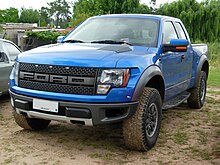
For the 2010 model year, Ford introduced the SVT Raptor model of the F-150. Intended for dedicated off-road use, the Raptor has a number of modifications to improve its off-road ability. It includes a full set of FOX shocks with 11.2" of front suspension travel and 12.1" of rear travel. It wears a wider body and wings than the standard F-Series truck. In a departure from the F-150, the Raptor wears no blue-oval Ford emblem on its grille (for the first time since 1981); instead, the grille has "FORD" spelled out in the center. In 2011, a full four-door SuperCrew lift kit model was added to the standard 4+4 door SuperCab model.
The Raptor is powered by a 411 hp 6.2-Liter V8 (shared with the Ford Super Duty; a 5.4 liter V8 was available for the 2010 model year); it is paired with a 6-speed automatic gearbox.
The Ford SVT Raptor was discontinued temporarily during the 2015 and 2016 model years as Ford worked to improve the Raptor. The new 2017 Ford SVT Raptor was reintroduced during the summer of 2015 and will be lighter, taking on the aluminum alloy body. The 6.2L V8 has been discontinued and replaced entirely with the 3.5L EcoBoost V6. It also will lose the SVT in its name and become simply called the Ford Raptor. The 2017 Ford Raptor will be heading to the dealerships in the fall of 2016 with a base price of $50,000-$53,000 (estimated) but can easily go over $60,000 with options.
F-150 Platinum

Ford ceased sales of the Lincoln Mark LT in the United States and Canada after the 2008 model year.[13] In its place, beginning in the 2010 model year, Ford created an upper-end trim of the F-150 called F-150 Platinum. Due to its continuing popularity there, the Platinum is rebadged as the Lincoln Mark LT in Mexico.
F-150 Tremor
For the 2014 model year, Ford introduced the Tremor model of the F-150. The Tremor was released as high-performance sport truck for street truck enthusiasts. The regular cab Tremor is based on the style of the FX Appearance Package with the 3.5 liter EcoBoost engine and a 4.10 rear axle. The interior uses a console-mounted shifter, custom bucket seats and a flow-through center console not found in any other F-150. The Tremor is available in both 4x2 and 4x4. Both options feature an electronic locking rear differential and customized suspension. 2230 total Tremor's were built
Motorsports
The truck won the San Felipe 250 eight times between 1999 and 2007.
Greg Biffle won the 2000 NASCAR Craftsman Truck Series.
Drivers such as Roger Norman and Larry Roeseler won the Primm 300 in 2003, 2007 and 2008.
In 2008, Ford announced its entrance into the Baja 1000 class-eight race for moderately modified, full-size pickups. The driver of record was Steve Oligos, supported by co-drivers Randy Merritt, Greg Foutz, and Bud Brutsman.[14] The vehicle was built with collaboration between the Ford Special Vehicle Team (SVT), Ford Racing, and Foutz Motorsports, Inc. The Ford F-150 SVT Raptor R completed the 2008 41st Tecate SCORE Baja 1000 race in 25.28:10,[15] and ranked third in its class.[16] Tavo Vildosola and Gus Vildosola won the event in 2010.
In the Best In The Desert race series, a F-150 SVT Raptor R completed the "Terrible's 250" race, placing second overall in the Class 8000.[17]
In January 2010, a single Raptor SVT (#439), driven by Chilean driver Javier Campillay, competed in the Argentina-Chile Dakar Rally. However, the pickup was unable to finish due to a catch-up crash with another car in the middle of the road during stage seven. In January 2011, two Raptors started in the Argentina-Chile Dakar Rally in Buenos Aires, with Campillay driving the more reliable Raptor (#375), and American female driver Sue Mead driving a T2 Raptor (#374). Mead crossed the finish line in Buenos Aires and won the "Super Production" class, the first North American class win in Dakar history. Campillay was unable to finish the 12th stage after losing time due to mechanical failure during the 11th stage, which led to his disqualification for failing to reach the race camp by the designated deadline.
Awards and recognition
The Ford F-150 has won numerous awards; in 2009 alone, it received:[18]
- Motor Trend 2009 Truck of the Year Award
- 2009 Best Redesigned Vehicle from Kelley Blue Book's kbb.com
- Top honors as "Truck of Texas" as well as "Best Luxury Pickup" for the 2009 F-150 King Ranch from Texas Auto Writers Association
- "Best Overall Half-Ton Pickup" from PickupTrucks.com
- "Automotive Excellence" award in the Workhorse Category from Popular Mechanics
- "Top Safety Pick" from the Insurance Institute for Highway Safety for its standard safety technology: Safety Canopy side curtain air bags and AdvanceTrac with Roll Stability Control
- "Residual Value" award from Automotive Leasing Guide (ALG) for retaining the highest percentage of its original price among 2009 full-size light-duty pickups at the end of a conventional three-year lease, based on ALG projections
- Motor Trend's Truck Trend Top 5 Pickups from Specialty Equipment Market Association (SEMA) for 2009 Ford F-150 Heavy Duty DeWalt Contractor Concept
- "Accessory-Friendly Pickup" Design Award from SEMA
Sales
| Calendar Year | United States | Canada | Norway | World |
|---|---|---|---|---|
| 1997 | 746,111[19] | |||
| 1998 | 836,629 | |||
| 1999[20] | 869,001 | |||
| 2000 | 876,716 | |||
| 2001[21] | 911,597 | |||
| 2002[22] | 813,701 | |||
| 2003 | 845,586 | 68,375 | 913,961 | |
| 2004[23] | 939,511 | 71,790 | 1,011,301 | |
| 2005 | 901,463 | 69,549 | 971,012 | |
| 2006[24] | 796,039 | 72,128 | 868,167 | |
| 2007 | 690,589 | 73,618 | 764,207 | |
| 2008[25] | 515,513 | 67,749 | 583,262 | |
| 2009[26] | 413,625 | 81,396 | 495,021 | |
| 2010[27] | 528,349 | 97,913 [28] | 626,262 | |
| 2011 | 584,917 | 96,325 | 681,242 | |
| 2012 | 645,316 | 106,358 [29] | 751,674 | |
| 2013 | 763,402[30] | 122,325 | 885,727 | |
| 2014 | 753,851[31] | 126,277[32] | 880,128 |
Other notes
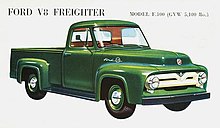
Ford also manufactures F-Series medium and heavy-duty pickups alongside the F-150, F-250, and F-350s (F-450, F-550, F-650, F-750 Super Duty trucks). Prior to 1998 in the United States, there were a number of variants sold alongside the F-Series.
- B-Series (1948-1998) - school bus chassis based on medium-duty F-Series
- Econoline/E-Series (1975-2014) - mechanically related to F-Series
- P-Series - parcel delivery van chassis
- An F-8000 was also produced based on the Ford Cargo cab-over range, which was similar to the 2006 and newer Ford LCF ("Low Cab Forward").
While previously a unique platform, after their 1975 redesign, the Econoline/E-Series vans have maintained strong similarity with the F-Series pickup trucks, although it is now only mechanically true, as the latter has now undergone a number of redesigns since the last update of the vans in 1992.
Medium-duty variants of the F-Series have their own chassis, sharing only the cab with lower-GVWR models. The current generation of F-650/F-750 Super Duty models combine the Ford Super Duty cab with a chassis shared with the International DuraStar line of trucks.
Right-hand drive versions of the F-Series (for the United Kingdom and Australia) are manufactured in Brazil.
In Argentina and Brazil, the petrol engines are often converted to also run with alternative fuels, E-96h (Brazilian-spec ethanol) and Compressed Natural Gas (CNG). Biodiesel also is used in diesel engines.
Special use F-Series vehicles
-
Lifeguard in Pismo Beach, California
-
Firetruck in Curico, Chile
-
Monster truck in Florida
-
Repairing power lines in Caruthersville, Missouri
-
Bus for disabled in Toronto
-
Police crowd control in Panama
-
Catering truck at John F. Kennedy International Airport
-
Farm vehicle
-
Microwave broadcasting vehicle in Chengkungling, Taiwan
-
Ambulance in Loudoun County, Virginia
-
At car wash in Round Rock, Texas
-
Special forces vehicle for hijacked planes in Italy
-
Railroad maintenance in Tampa, Florida
-
Seafood delivery in Scranton, Pennsylvania
-
Taxi in Saint Thomas, U.S. Virgin Islands
-
Motorcade for U.S. President George W. Bush in Zagreb, Croatia
-
Camper at Core Banks, North Carolina
-
Tow truck in Horsens, Denmark
-
U.S. Border Patrol in Tucson
-
Dump truck in Ottawa
-
WikiLeaks Top Secret Information Collection Unit in New York City
-
Mosquito Control in New Orleans
-
Race car in Avondale, Arizona
See also
- Ford Super Duty
- Ford F-650
- Sterling Trucks Bullet pickup
References
- ^ "Auto sales reach six-year high of 15.6 million vehicles sold, Ford F-Series takes the lead". NY Daily News. 2014-01-06.
- ^ Ford Motor Company (2007-05-25). "Ford's Best Selling Pickups Add More Features For 2008". Truck Trend. Auto News.
- ^ Cato, Jeremy (2010-03-25). "Top 10 best-selling vehicles - The Globe and Mail". The Globe and Mail. Toronto.
- ^ Cluczyk, Barry (December 2012), "Ford F-150 - Boosting The EcoBoost", Truckin Magazine
- ^ "Five Ford Vehicles Made the 200,000-Mile List". Ford.com. Retrieved May 27, 2014.
- ^ Korzeniewski, Jeremy (13 January 2014). "2015 Ford F-150 brings big aluminum to the Rust Belt [w/video]". Retrieved 14 January 2014.
- ^ a b 2015 Ford F-150 First Look - Motor Trend
- ^ "2015 F-150: Ford drops an aluminum blockbuster". SAE. SAE International. Retrieved 24 April 2014.
- ^ http://www.autonews.com/article/20150529/OEM01/150529839/ford-f-150-output-pinched-by-frame-shortage-workers-say
- ^ http://www.prnewswire.com/news-releases/metalsa-to-acquire-dana-holding-corporations-structural-products-business-79443307.html
- ^ http://www.autoblog.com/2015/04/16/2015-ford-f150-five-star-crash-rating-video/
- ^ "New 2010 Ford Harley-Davidson F-150: tough truck with cool attitude; new details, inside and out". Media.ford.com. February 10, 2009. Retrieved 2009-04-28.
- ^ "RIP: Lincoln Mark LT". September 2007. Retrieved 2007-09-04.
- ^ "Ford SVT F-150 Raptor R to enter Baja 1000". Fordnewsblog.wordpress.com. 2008-11-26. Retrieved 2010-10-19.
- ^ Phillips, Drew (2008-11-25). "Ford F-150 SVT Raptor R completes inaugural run of Baja 1000". Autoblog.com. Retrieved 2010-10-19.
- ^ 2008 Baja 1000 class results
- ^ "2010 FORD F150 SVT RAPTOR R CAPTURES PODIUM FINISH; PRICING ANNOUNCED". Ford-trucks.com. Retrieved 2010-10-19.
- ^ "2009 FORD F-150 AWARDS". Media.ford.com. 2008-12-16. Retrieved 2010-10-19.
- ^ http://media.ford.com/article_print.cfm?article_id=872
- ^ "Ford Motor Company Sets New Full Year U.S. Sales Record". Theautochannel.com. Retrieved 2009-04-28.
- ^ "Ford Motor Company's December U.S. Sales Climb 8.2 Percent" (PDF). Ford Motor Company.
- ^ "Ford's F-Series Truck Caps 22nd Year in a Row as America's Best-Selling Vehicle With a December Sales Record". Theautochannel.com. 2004-11-17. Retrieved 2009-04-28.
- ^ "Ford Achieves First Car Sales Increase Since 1999". Theautochannel.com. 2004-11-17. Retrieved 2009-04-28.
- ^ "Ford Motor Company 2007 sales". January 3, 2008.
- ^ "F-Series drives ford to higher market share for third consecutive month" (PDF). Ford Motor Company. January 5, 2009. Retrieved 2009-05-14.
- ^ "FORD CAPS 2009 WITH 33 PERCENT SALES INCREASE, FIRST FULL-YEAR MARKET SHARE GAIN SINCE 1995" (PDF). Ford Motor Company. January 5, 2010. Retrieved 2010-01-05.
- ^ "Ford's 2010 Sales Up 19 Percent - Largest Increase of Any Full-Line... - DEARBORN, Mich., Jan. 4, 2011 /PRNewswire/". Michigan: Prnewswire.com. Retrieved 2011-10-23.
- ^ "STRONG CAR SALES DRIVE FORD TO #1 IN CANADA | Ford Motor Company Newsroom". Media.ford.com. 2011-01-04. Retrieved 2011-10-23.
- ^ "Ford is top-selling automaker in Canada for three consecutive years" (Press release). Ford. 2013-01-03. Retrieved 2013-01-04.
- ^ http://media.ford.com/content/dam/fordmedia/North%20America/US/2014/01/december13sales.pdf
- ^ https://media.ford.com/content/dam/fordmedia/North%20America/US/2015/01/05/december2014sales.pdf
- ^ http://driving.ca/ram/1500/auto-news/news/top-10-best-selling-new-vehicles-in-canada
External links
- Ford F-Series
- Pickup trucks
- Rear-wheel-drive vehicles
- All-wheel-drive vehicles
- 1940s automobiles
- 1950s automobiles
- 1960s automobiles
- 1970s automobiles
- 1980s automobiles
- 1990s automobiles
- 2000s automobiles
- 2010s automobiles
- Vehicles introduced in 1948
- Flexible-fuel vehicles
- Motor vehicles manufactured in the United States
























